Production of infectious chimeric hepatitis C virus genotype 2b harboring minimal regions of JFH-1
- PMID: 22156532
- PMCID: PMC3302416
- DOI: 10.1128/JVI.05386-11
Production of infectious chimeric hepatitis C virus genotype 2b harboring minimal regions of JFH-1
Abstract
To establish a cell culture system for chimeric hepatitis C virus (HCV) genotype 2b, we prepared a chimeric construct harboring the 5' untranslated region (UTR) to the E2 region of the MA strain (genotype 2b) and the region of p7 to the 3' UTR of the JFH-1 strain (genotype 2a). This chimeric RNA (MA/JFH-1.1) replicated and produced infectious virus in Huh7.5.1 cells. Replacement of the 5' UTR of this chimera with that from JFH-1 (MA/JFH-1.2) enhanced virus production, but infectivity remained low. In a long-term follow-up study, we identified a cell culture-adaptive mutation in the core region (R167G) and found that it enhanced virus assembly. We previously reported that the NS3 helicase (N3H) and the region of NS5B to 3' X (N5BX) of JFH-1 enabled replication of the J6CF strain (genotype 2a), which could not replicate in cells. To reduce JFH-1 content in MA/JFH-1.2, we produced a chimeric viral genome for MA harboring the N3H and N5BX regions of JFH-1, combined with a JFH-1 5' UTR replacement and the R167G mutation (MA/N3H+N5BX-JFH1/R167G). This chimeric RNA replicated efficiently, but virus production was low. After the introduction of four additional cell culture-adaptive mutations, MA/N3H+N5BX-JFH1/5am produced infectious virus efficiently. Using this chimeric virus harboring minimal regions of JFH-1, we analyzed interferon sensitivity and found that this chimeric virus was more sensitive to interferon than JFH-1 and another chimeric virus containing more regions from JFH-1 (MA/JFH-1.2/R167G). In conclusion, we established an HCV genotype 2b cell culture system using a chimeric genome harboring minimal regions of JFH-1. This cell culture system may be useful for characterizing genotype 2b viruses and developing antiviral strategies.
Figures
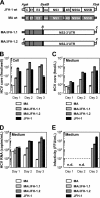
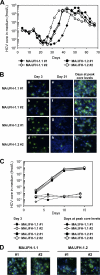
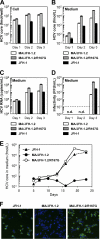
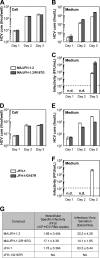
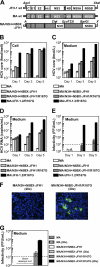
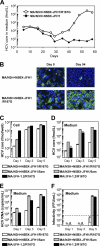
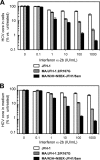
Similar articles
-
Amino Acid Mutations in the NS4A Region of Hepatitis C Virus Contribute to Viral Replication and Infectious Virus Production.J Virol. 2017 Jan 31;91(4):e02124-16. doi: 10.1128/JVI.02124-16. Print 2017 Feb 15. J Virol. 2017. PMID: 27928005 Free PMC article.
-
The NS3 helicase and NS5B-to-3'X regions are important for efficient hepatitis C virus strain JFH-1 replication in Huh7 cells.J Virol. 2007 Aug;81(15):8030-40. doi: 10.1128/JVI.02088-06. Epub 2007 May 23. J Virol. 2007. PMID: 17522229 Free PMC article.
-
Efficient infectious cell culture systems of the hepatitis C virus (HCV) prototype strains HCV-1 and H77.J Virol. 2015 Jan;89(1):811-23. doi: 10.1128/JVI.02877-14. Epub 2014 Oct 29. J Virol. 2015. PMID: 25355880 Free PMC article.
-
[Production of infectious hepatitis C virus in cell culture].Uirusu. 2005 Dec;55(2):287-95. doi: 10.2222/jsv.55.287. Uirusu. 2005. PMID: 16557015 Review. Japanese.
-
Cell Culture Systems of HCV Using JFH-1 and Other Strains.Cold Spring Harb Perspect Med. 2019 Nov 1;9(11):a036806. doi: 10.1101/cshperspect.a036806. Cold Spring Harb Perspect Med. 2019. PMID: 31501261 Free PMC article. Review.
Cited by
-
Highly efficient full-length hepatitis C virus genotype 1 (strain TN) infectious culture system.Proc Natl Acad Sci U S A. 2012 Nov 27;109(48):19757-62. doi: 10.1073/pnas.1218260109. Epub 2012 Nov 14. Proc Natl Acad Sci U S A. 2012. PMID: 23151512 Free PMC article.
-
A novel strategy to develop a robust infectious hepatitis C virus cell culture system directly from a clinical isolate.J Virol. 2014 Feb;88(3):1484-91. doi: 10.1128/JVI.02929-13. Epub 2013 Nov 13. J Virol. 2014. PMID: 24227861 Free PMC article.
-
Construction of a chimeric hepatitis C virus replicon based on a strain isolated from a chronic hepatitis C patient.Virol Sin. 2014 Feb;29(1):61-70. doi: 10.1007/s12250-014-3408-z. Epub 2014 Jan 20. Virol Sin. 2014. PMID: 24452538 Free PMC article.
-
Efficient Hepatitis C Virus Genotype 1b Core-NS5A Recombinants Permit Efficacy Testing of Protease and NS5A Inhibitors.Antimicrob Agents Chemother. 2017 May 24;61(6):e00037-17. doi: 10.1128/AAC.00037-17. Print 2017 Jun. Antimicrob Agents Chemother. 2017. PMID: 28348150 Free PMC article.
-
Adapted J6/JFH1-based Hepatitis C virus recombinants with genotype-specific NS4A show similar efficacies against lead protease inhibitors, alpha interferon, and a putative NS4A inhibitor.Antimicrob Agents Chemother. 2013 Dec;57(12):6034-49. doi: 10.1128/AAC.01176-13. Epub 2013 Sep 23. Antimicrob Agents Chemother. 2013. PMID: 24060868 Free PMC article.
References
-
- Bartenschlager R, Lohmann V. 2000. Replication of hepatitis C virus. J. Gen. Virol. 81:1631–1648 - PubMed
-
- Boulant S, et al. 2006. Structural determinants that target the hepatitis C virus core protein to lipid droplets. J. Biol. Chem. 281:22236–22247 - PubMed
-
- Boulant S, Targett-Adams P, McLauchlan J. 2007. Disrupting the association of hepatitis C virus core protein with lipid droplets correlates with a loss in production of infectious virus. J. Gen. Virol. 88:2204–2213 - PubMed
-
- Choo QL, et al. 1989. Isolation of a cDNA clone derived from a blood-borne non-A, non-B viral hepatitis genome. Science 244:359–362 - PubMed
Publication types
MeSH terms
LinkOut - more resources
Full Text Sources
Other Literature Sources
Medical

